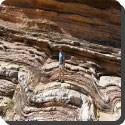 When you pick up a pebble on the beach, it is hard to imagine that this solid material rock, can be bent just as though it were toothpaste. Throughout the world, however, you can find large areas of exposed rock that clearly show the evidence of bending. It is also important to realize that it is the bending and upheaval of the surface rocks which give rise to the basic structure from which the landscape is moulded. Some of the folds which have been formed in beds of rock are so large that you cannot see their complete shape. Their existence can be proved by other methods.
When you pick up a pebble on the beach, it is hard to imagine that this solid material rock, can be bent just as though it were toothpaste. Throughout the world, however, you can find large areas of exposed rock that clearly show the evidence of bending. It is also important to realize that it is the bending and upheaval of the surface rocks which give rise to the basic structure from which the landscape is moulded. Some of the folds which have been formed in beds of rock are so large that you cannot see their complete shape. Their existence can be proved by other methods.
Geologists try to simplify the business of examining folded rocks by giving characteristic forms names. Take a piece of paper to help you learn some of the folds that can be seen in nature. First of all, bend the sheet into a gentle curve and hold it so that the bend is at the top as you look at it. When rocks are bent into this shape it is called an antiform. Now, instead of using just one sheet, do the same thing with a number of sheets held together. Try to imagine that each sheet of paper is a bed of rock and that the bottom sheet was the first bed to be laid down, in other words the oldest. Now hold the fold in one hand and cut off the top of the curve with scissors.
You will see that the sheet that was at the bottom is now in two halves at the center of the sheet of the paper. When this happens to folded rocks, and the oldest beds occur in the center of an antiform, it is called an anticline. Sometimes if there is more than on period of movement, what was at first an anticline can be turned upside down, and the situation becomes quite confusing.
Of course, beds of rock in the Earth’s crust are rather longer than your piece of paper and you would not expect to find just one fold. Take the sheet of paper and put two gentle folds in it. You will see that one has its bend at the top, the antiform, but the other has its bend at the bottom; this called a synform. When there are younger rocks in the center of the synform it is called a syncline. With many periods of upheaval, then you can see that there could be synformal anticlines and antiformal synclines. Sometimes, rocks are bent into dome and basin shapes.
 Kids Portal For Parents India Kids Network
Kids Portal For Parents India Kids Network






